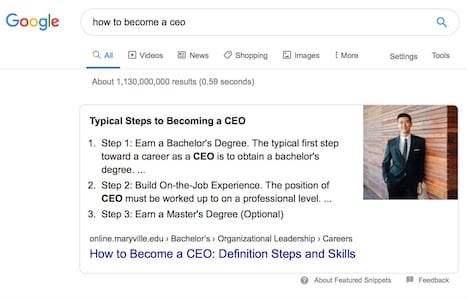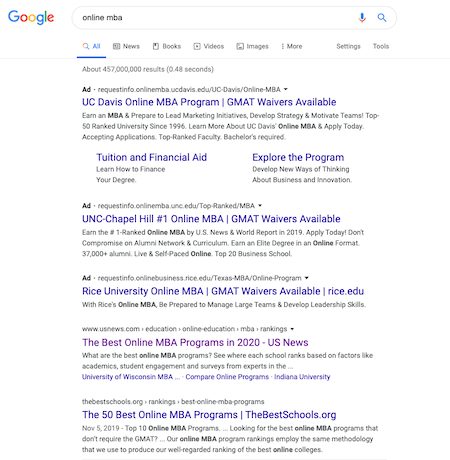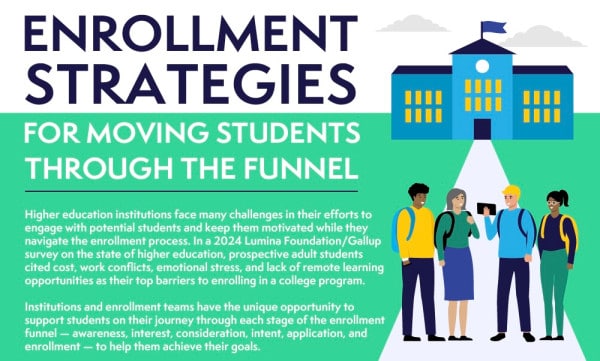Boost Your Enrollment Cycle With These Higher Ed SEO Strategies
Billions of queries occur daily through global search engines on desktop, mobile, and voice devices. These organic searches are the largest drivers of website traffic, particularly for higher education institutions, making SEO an essential ingredient in the recipe for generating student leads. A student’s journey toward enrollment is a roller coaster of considerations. From looking at financial costs and career opportunities to assessing workloads and faculty projects, students turn to search engines to answer their questions.
Optimizing your university’s website involves looking at a variety of SEO factors: webpage speed, page titles and headings, URL structure, link building, content, and more. Here at Archer, our higher education SEO team members have expert insight at every step on the path toward optimizing a university’s website, including technical on-page improvements, off-page link building, and, most importantly, content creation and promotion.
Let’s explore how your institution can stay relevant and bring new prospective students in with a sophisticated higher education SEO strategy.
SEO for Higher Education: What You Need to Know
Online content saturation is at an all-time high, and competition in higher ed is intensifying. Meanwhile, the audiences that institutions are marketing to have become less traditional.
Capturing the attention of prospective students at a critical point in their college enrollment journey takes a deep understanding of all the nuances of search engine optimization, including search intent, click-through rates, and mobile experience. To create content that will engage online audiences, universities must have strong SEO strategies to ensure brand discovery.
7 SEO Strategies to Boost Your College Enrollment Cycle
Our higher ed SEO experts have pulled together a list of seven strategies to help capture students along their path to college enrollment. Their expertise will help guide you in discerning what’s important in an SEO strategy and where to set focus for the rest of the year.
1. Determine Your Student Journey
Student journey maps are going to be key in helping you guide the focus and intent of your content. How are you making students aware of your programs? At what point are they considering your programs? Where in the journey do they make a decision, and what do they need to get there?
Students looking to advance their academic and professional careers are at some point in the sales funnel, but they’re also at some stage in their search engine journey. If you’re doing it right, you’ve constructed this journey carefully and provided several different routes for the different kinds of prospective students you interact with.
For example, a student might be only tangentially familiar with the construction industry, so you can gain their interest by crafting a piece about construction careers that graduates can enter after receiving a construction management degree. On the other hand, a student might be further along in their journey and might be at the point of more serious consideration of an engineering degree. For this student, you can craft a post about stress management for engineering students.
If you want to get students to your website, finding blog topics is only half the game. Using keywords to optimize your content is how you push those posts to the finish line. Google’s latest algorithms emphasize value, so figure out what value you can provide your reader at every stage of inquiry.
By walking through the student’s college enrollment experience and differentiating content based on the needs of each stage, you can curate specific content to respond to their search intent, keep them engaged with your brand, and guide them down your content map to a post that encourages them to convert.
2. Satisfy Student Search Intent
Since search intent is Google’s ultimate goal, when it comes to SEO for higher education, keyword research and content creation that match the student’s search intent should be a primary focus.

The “How to Become a CEO” article above is a great example of a university-created piece of content that matches search intent and provides steps that show how the university program can help the searcher accomplish their goal. Content should discuss a range of topics that align with the university’s mission and program’s course curriculum while still keeping the searcher top of mind. With each piece of content, you’ll be able to attract a variety of students who are in different places in the student discovery process.
Each of these posts should have a strong call to action (CTA) that intrigues prospective students to learn more about the university’s program and how they can become more involved and apply. This CTA can include an aesthetically pleasing “learn more” button that directs readers to a “request more information” form.
3. Apply Google’s Helpful Content Update Learnings
In 2023, Google introduced a new helpful content algorithm intended to help searchers find relevant results. This update is intended to weed out nonhelpful search results, defined as content that lacks experience, expertise, authoritativeness, or trustworthiness (E-E-A-T).
What does this mean for universities? Crafting high-quality content that meets student search intent is even more important. Instead of focusing solely on SEO keywords, university website pages and blogs need to meet Google’s quality standards in one or more E-E-A-T fields.
- Experience: The content is created by someone with firsthand involvement in the subject matter.
- Expertise: The content creator has formal knowledge of the subject matter.
- Authoritativeness: The content contains credible information, and the website has a good reputation for providing quality content.
- Trustworthiness: The content includes clear and transparent sourcing to verify the accuracy and reliability of the information.
Universities can meet these expectations by providing high-quality information that highlights faculty and student experiences and expertise.
4. Elevate Your Content Strategy
Searchers are no longer satisfied with traditional text-based content or boring images. This is especially true for millennials and Gen Zers, who account for 42% of the U.S. population, according to Statista, and the majority of a university’s target market.
To capture the attention of these easily distracted searchers, higher education SEO strategies should branch out beyond traditional articles and infographics to include visually captivating and psychologically intriguing content, such as interactive graphics or videos. This refreshed content strategy should aim to not only catch a searcher’s immediate attention but also leave a lasting brand imprint to intrigue searchers to come back for more.
Check out the following example of an engaging piece of content from Zippia.com that outlines the different career paths for cost accountants. The piece is interactive, allowing the user to move their mouse along the different career paths to reveal more detailed and relevant information.
This interactive map is fun and easy to use while still providing the quality and quantity of content the user is looking for. It illustrates the kind of memorable yet useful experience required to capture a student’s attention.
5. Occupy Google Search Results

Occupying more real estate on ever-evolving search engine results pages (SERPs) is more crucial than ever. A large number of Google searches do not result in a click. With the advent of more featured snippets, the importance of a technically sound website, structured data, and high-quality content grows.
While on-page SEO is still crucial for ranking on the SERP, off-page efforts and creating a user experience (UX) that expands past your website are the next wave of occupying internet real estate. Off-page citations, or references to your institution on websites such as U.S. News and Wikipedia, will push hints and signals to Google that validate your brand. Quality higher education SEO strategies should also include a UX that helps your site stand out in today’s saturated marketplace.
6. Optimize Your Website for Mobile
To enhance the college enrollment funnel experience, you need to maintain the health of your website for both desktop and mobile.
Since a majority of search engine visits come from mobile devices, there’s no question that higher education SEO teams should be focusing on the mobile user experience of their websites. Now that Google has mobile-first indexing best practices, your team has new factors to consider. If your website’s content differs between desktop and mobile, for example, then your site is at risk of having pages not indexed or crawled, which could result in a significant loss of traffic.
For starters, ensure that desktop and mobile versions of your website have identical content, as well as identical technical elements, such as structured data and meta tags. Whether you’re developing content or updating your website design, always be sure to consider both platforms in any updates you make.
7. Understand Your Competition

With Google ads for search terms like “online mba” generating a high cost per click (CPC), higher education is one of the most competitive segments of search engine rankings. Why? Simply put, graduate degree programs are expensive and have large marketing budgets. In addition, affiliate marketing is rampant in the higher education space. What’s affiliate marketing? Affiliate marketers in higher education essentially sell student leads to universities.
These affiliate sites often have large SEO budgets and benefit from degree ranking and badging tactics. Take a look at the density of non-edu sites in the search results by Googling “online mba.”
In addition to competing with a number of affiliate websites, traditional schools have to compete with for-profit institutions and institutions with powerful national and regional brands.
Despite the competitive market, a long-term higher education SEO strategy, with a nuanced understanding of the market, can yield tremendous results around student enrollments and thought leadership.
SEO for Higher Education: Boost Your Results with Archer
Here at Archer Education, we partner with accredited universities to help higher-ed leaders and marketers accelerate online learning growth and enrollment. We offer a variety of tech-enabled marketing, enrollment, and retention services, and our team of SEO experts is always up to date on strategies to help your program gain visibility in prospective students’ search results.
Our SEO tactics can help your university:
- Increase its visibility in student-generating keywords
- Grow the amount of organic traffic to the site
- Ensure its site is optimized for organic search
Contact us or visit our SEO tactics page to learn more about how Archer can help you reach your enrollment goals.
Sources
Backlinko, Search Intent and SEO: A Complete Guide
Forbes, “Understanding Google’s Mobile-First Indexing To Generate More Traffic To Your Website”
National Student Clearinghouse Research Center, Current Term Enrollment Estimates
Statista, U.S. population Share by Generation 2023
Zippia, How To Become A Cost Accountant: What It Is and Career Path


